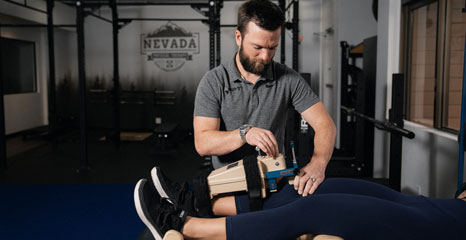As the famed philosophizing physical therapist, Erik Meira muses “it’s the quads until it’s not” and this is reflected throughout not only our testing but also our programming. Specifically we begin in the early phase with a focus on normalizing quad recruitment as we facilitate the resolution of the post-surgical trauma with progressions into modified knee extension isometrics and isotonic strengthening within the first few weeks. Early, safe quad loading is essential to being able to wean off crutches as well as protecting the newly reconstructing ligament.
Restoring the knee extension strength goes beyond just limb symmetry, i.e. how strong the quadriceps are compared to the non-surgical leg, to focusing on how strong you should be? Limb symmetry serves as a low-level benchmark in the early phases and is measured with in-line dynamometry. Why dynamometry? If a physical therapist even measures strength (42% do not), many use the classic “manual resistance” grading scale. The problem with this approach is that not only is it highly dependent on who is testing you, but individuals have to demonstrate at least a 20% strength deficit before we can reliably identify weakness. With dynamometry testing we can reproduce accurate strength numbers regardless of who is doing the testing and we can normalize those numbers to your body weight (which is what the research recommends).
Specifically, the amount of torque you demonstrate is converted into a ratio with a goal of 1.0 ft-lbs./lb. BW as research showing that athletes who meet or exceed this goal demonstrate an 8x higher rate or returning to their previous level of competitive activity compared to those that did not. In fact, just a 30% deficit below this number (not limb symmetry, mind you….torque to bodyweight!) consistently demonstrated subjective scores 17 points below their counterparts when rating their own knee function. For more information on why torque matters and why it is essential to test, click here.
While improved quad strength was associated with “greater knee-joint function, greater readiness to return to functional activity, and more positive emotions connected to the injury process”, we do not stop the testing with isometric testing in isolation. We also examine peak power (how strong AND how fast), functional strength (single leg squatting, Y-balance testing, etc.) as well as force plate testing to give us (and you) a comprehensive picture of how strong the knee actually is. Manual resistance and triple hop testing are a thing of the past and Nevada Physical Therapy has developed one of the most detailed, evidence-based testing batteries for individuals with ACL reconstructions in not only the Reno-Sparks area but in the nation.

Sam S.
Patient
The best PT clinic out there! After my third ACL replacement I came to Nevada PT to work on my recovery. Dakota was a spectacular therapist and got me into the best shape of my life. The care they offer is far superior to the other physical therapy clinics I used in the past and I couldn't have asked for a better experience!
Read More ReviewsAleem
Patient
I cannot say enough positive things about this place. Came in with an ACL injury. I spent a few weeks working with jonathan. His evidence-based approach and motivational ability was really really inspiring. He helped me get back to normal and then some!
Read More ReviewsJamie F.
Patient
I had ACL and meniscus replacement surgery and was referred to Nevada Physical Therapy by my doctor. The owner, John, was incredibly knowledgeable, and the front staff are helpful and warm. But the real star of the show is Nick D'Agostino. His approach utilizes both physical and mental strength exercises[...]
Read More ReviewsTaylor R.
Patient
While working as a local first responder I tore my ACL several months ago. Various co-workers/friends recommended to see Jon as he has helped rehab them and yielded great results. Shortly after, I had my surgery to repair the knee and began seeing Jon. Immediately, Jon discussed his process and explained the different stages of my rehab[...]
Read More ReviewsEric W.
Patient
I saw NVPT for several months after my knee surgery. I really liked the staff (Ellie, Dakota, Britney, and Tristan). What really impressed me was how their training programs were based on the latest evidence-based research. Dakota developed a plan that allowed me to stay active while recovering so I never felt too sidelined by the injury[...]
Read More ReviewsAlex O.
Patient
Nevada Physical Therapy is by far the best physical therapy office in town. As a soccer player, injuries are a common occurrence, but Brian helped me through a particularly nasty ACL tear and it has easily been one of the best recoveries I've had [...]
Read More Reviews